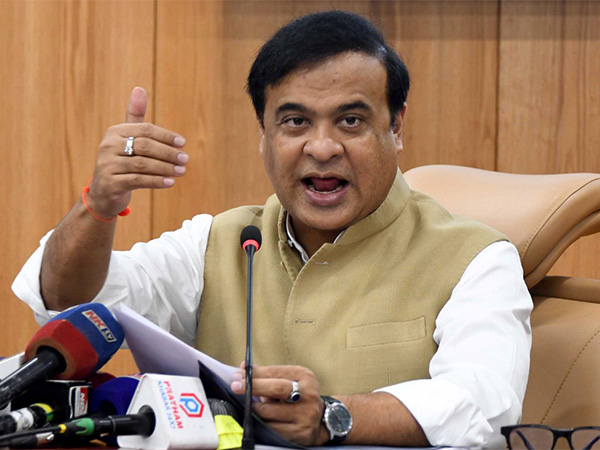Guwahati (Assam) [India], September 9 (ANI): Assam Chief Minister Himanta Biswa Sarma on Sunday launched the escalation matrix, e-Chitha, land valuation certificate, and community response portal of ASDMA at a function held at Srimanta Sankardeva Kalakshetra in Guwahati.
It may be noted that with the help of the escalation matrix, a timeframe will be set for handling and disposing of the matters contained in the ARTPS Act. With the help of E-chitha through ‘the’sewa setu portal’, buyers will get the facility to get into the history of any piece of land, like the names of its owners in Assam, for the purpose of buying. A land valuation certificate will enable the buyers and sellers to get valuation information about a piece of land.
The community response portal of ASDMA will help various NGOs, volunteers, along with the government to provide aid to the disaster victims in times of any disaster.
Speaking at the launching ceremony, which was organised by the Revenue and Disaster Management Department, where a workshop for Mission Basundhara (MB) 3.0 was also organised, Chief Minister CM Sarma said that the services launched will revolutionise the public services delivery system in the state.
He also said that these services will also help in the effective implementation of Mission Basundhara 3.0, which will be launched on October 2.
“The Mission Basundhara 1.0 and Mission Basundhara 2.0 helped many landless indigenous people to secure their rights on the land. The successes and challenges faced during Mission Basundhara 1.0 and 2.0 have enabled the government to take steps for making Mission Basundhara 3.0 more effective and beneficiary friendly. All preparations have been taken for rolling out of Mission Basundhara 3.0. Moreover, the two-day workshop on the preparedness of Mission Basundhara 3.0 held at Srimanta Sankardeva Kalakshetra will also help all the stake holders to reorient themselves for the successful implementation of Mission Basundhara 3.0,” the Assam Chief Minister said.
CM Sarma said that Mission Basundhara 1.0, which was launched on 2 October, 2021, benefitted around eight lakh people. Moreover, Mission Basundhara 2.0, which was launched on November 14, 2022 also benefitted more than two lakh people.
“Taken together, Mission Basundhara 1.0 and 2.0 ensured land rights to around 84 per cent indigenous people, SC and ST of the state. Moreover, in Mission Basundhara 3.0, the cases will also be taken where an offer of settlement could not be given to the beneficiaries in MB 2.0. One of the criteria for being considered for MB 3.0, a beneficiary should be living on the piece of land for three generations. However, this criterion would be exempted for the people belonging to tea tribes, Adivasi, the Gorkha community, and people belonging to six ethnic communities in the state. These classes will be declared as protected classes, and they will be considered for allotting land pattas under MB 3.0. without any evidence of a three-generation legacy associated with the piece of land. This move of the government will greatly benefit the indigenous people of the state,” the Chief Minister added.
CM Sarma also said that during MB 3.0, claims for land for educational institutions like colleges and universities will be given preference. Moreover, he said that it was observed that some of the beneficiaries, even after being eligible for land pattas under Mission Basundhara 2.0, could not regularise their rights because of their inability to pay high premium of land.
“Therefore, the government, decided that in MB 3.0 for the lands falling in towns and cities, the beneficiaries will be allowed to regularise their possession by paying less premium against the government rate. However, if they want to sell the land, the unrealised premium will have to be paid to the government from the amount thus realised from the sale of the land. This system, according to the Chief Minister, will also ensure land rights for the indigenous people,” the Chief Minister said.
The Chief Minister, on the occasion, also presented commendation on the performance of Flood Preparedness Score Cards (FPSC). FPSC is based on a self-reporting mechanism in which the districts are required to report their preparedness in accordance with pre-defined minimum preparedness standards (MPS) and indicators. Based on their responses, the districts and line departments are then evaluated.
Accordingly, among the districts, the first position was awarded to Morigaon and Nalbari districts together. The second position was secured by Cachar district, followed by Golaghat and Majuli districts that secured the third position.
Moreover, among the departments, the first position was awarded to the Women and Child Development department, the second position was secured by the Water Resources, Education, and PWD Roads departments, and the third position was secured by the Assam State Disaster Management Authority (ASDMA).
The Chief Minister congratulated the awardees and said that their response in dealing with flood preparedness has the potential to help the people in mitigating the effects of floods and assuaging their sufferings. (ANI)
Disclaimer: This story is auto-generated from a syndicated feed of ANI; only the image & headline may have been reworked by News Services Division of World News Network Inc Ltd and Palghar News and Pune News and World News
HINDI, MARATHI, GUJARATI, TAMIL, TELUGU, BENGALI, KANNADA, ORIYA, PUNJABI, URDU, MALAYALAM
For more details and packages











